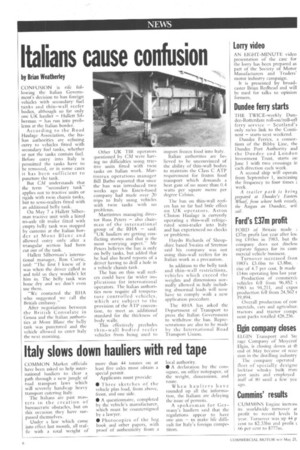Italians cause confusion
Page 8

If you've noticed an error in this article please click here to report it so we can fix it.
by Brian Weatherley
CONFUSION is rife following the Italian Government's decision to ban foreign vehicles with secondary; fuel tanks and thin-wall reefer bodies, although so far only one UK haulier — Hallett Silberman — has run into problems at the Italian border.
According to the Road Haulage Association, the Italian authorities are refusing entry to vehicles fitted with secondary fuel tanks, whether or not the tanks contain fuel. Before entry into Italy is permitted the tanks have to be removed, or in some cases it has been sufficient to puncture the tank. But CM understands that the term "secondary tank" applies not to tractive units or rigids with twin chassis tanks, but to semi-trailers fitted with an additional belly tank.
On May 7 a Hallett Silberman tractive unit with a hired tri-axle tilt trailer fitted with empty belly tank was stopped by customs at the Italian border at Mont Blanc and allowed entry only after a triangular section had been cut out of the tank.
Hallett Silberman's international manager, Ron Currie, said: "The first I knew of it was when the driver called in and told us they wouldn't let him in. The belly tank was bone dry and we don't even use them.
"We contacted the RHA who suggested we call the British embassy."
After negotiations between the British Consulate in Genoa and the Italian authorities at Mont Blanc the belly tank was punctured and the vehicle allowed to enter Italy the next morning.
Other UK TIR operators questioned by CM were having no difficulties using tractive units fitted with twin tanks on Italian work. Martintrux operations manager Bill Batho reported that since the ban was introduced two weeks ago his Essex-based company had made over 20 trips to Italy using vehicles with twin tanks with no problems.
Martintrux managing director Russ Peters — also chairman of the international group of the RHA — said: "LIK hauliers are getting conflicting stories and that is the most worrying aspect." Mr Peters believes the ban is only on belly tanks, but added that he had also heard reports of a driver having to drill a hole in a vehicle chassis tank.
The ban on thin wall reefers could have far wider implications for international operators. The Italian authorities now require all temperature controlled vehicles, which are subject to the provision of the ATP convention, to meet an additional standard for the thickness of body walls.
This effectively precludes thin-wall bodied reefer vehicles from being used to import frozen food into Italy. Italian authorities are believed to be unconvinced of the ability of thin-wall bodies to maintain the Class C ATP requirement for frozen food transport which demands a heat gain of no more than 0.4 watts per square metre per degree Celsius.
The ban on thin-wall reefers has so far had little effect on UK operators. Aston Clinton Haulage is currently operating a thin-wall refrigerated semi-trailer into Italy and has experienced no checks or problems.
Haydn Richards of Shropshire based Swains of Stretton said his company was not using thin-wall reefers for its Italian work as a precaution.
In addition to the belly tank and thin-wall restrictions, vehicles which exceed the weights and dimensions normally allowed in Italy including abnormal loads will now have to comply with a new application procedure.
The RHA has asked the Department of Transport to press the Italian Government to withdraw the ban. Representations are also to be made by the International Road Transport Union.












































































































